Recent News
- Controlled loading of MoS2 on hierarchical porous TiO2 for enhanced photocatalytic hydrogen evolution July 19, 2021
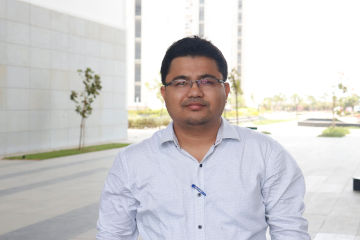 Ever since the breakthrough research on H2 photogeneration from water using TiO2 under UV-light irradiation, an enormous amount of research has been conducted on photochemical H2 evolution using different semiconductor-based photocatalysts. Consequently, a research paper titled “Controlled Loading of MoS2 on Hierarchical Porous TiO2 for Enhanced Photocatalytic Hydrogen Evolution” has been published by Prof Ranjit Thapa, Professor of Physics, SRM University – AP, as a co-author, in The Journal of Physical Chemistry C, having an Impact Factor of 4.189.
Ever since the breakthrough research on H2 photogeneration from water using TiO2 under UV-light irradiation, an enormous amount of research has been conducted on photochemical H2 evolution using different semiconductor-based photocatalysts. Consequently, a research paper titled “Controlled Loading of MoS2 on Hierarchical Porous TiO2 for Enhanced Photocatalytic Hydrogen Evolution” has been published by Prof Ranjit Thapa, Professor of Physics, SRM University – AP, as a co-author, in The Journal of Physical Chemistry C, having an Impact Factor of 4.189.In this work, Prof Thapa describes three important factors for helping in the generation of hydrogen using proposed MoS2/TiO2 catalyst, (i) TiO2 for effective charge transfer, (ii) MoS2 for plasmon induction (iii) large surface area and active sites. It was shown that hierarchical porous TiO2 can be interfaced successfully with marigold-flower-like MoS2 flakes with intriguing photophysical properties, viz., visible-light response, controlled electron−hole recombination, and sustainable H2 production over prolonged light irradiation due to the synergic effect of flowerlike MoS2 and the fibrous wormhole mesoporous channel of TiO2. Further, the researchers have used density functional theory (DFT) to identify the active sites and calculated the change in Gibbs free energy (ΔGH). “We have also studied the charge density difference to understand about electron transfer pathway. The change free energy of hydrogen adsorption (ΔGH*) is a good indicator to estimate the hydrogen evolution activity in the acidic medium. From the DFT study, it is clear that O sites of MPT heterostructure are more favourable for HER reactivity”, said Prof Ranjit Thappa.
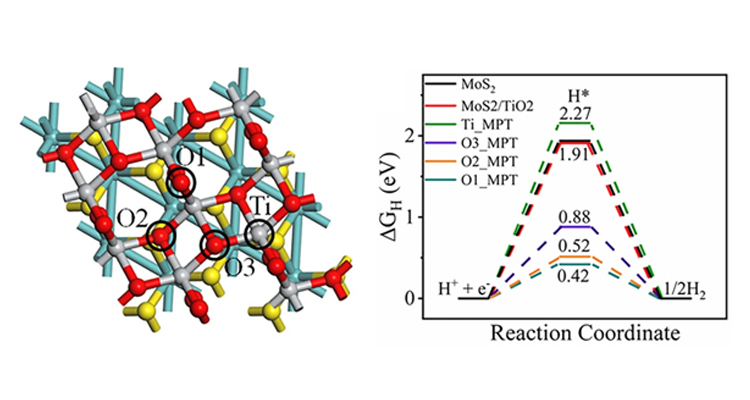
Social implications of the research:
In the last few decades, with the decline in non-renewable resources and increasing environmental pollution, significant attention has been given to renewable and clean energy domains. Hydrogen is considered one of the most suitable energy carriers due to its higher energy density per unit mass in comparison to other chemical fuels. In recent times, photocatalytic fission (Photocatalysis is a process in which light energy is used to drive pairs of chemical reactions. Through the absorption of light, an excited electron/hole pair is produced) of water has been considered an attractive solution for solar to chemical H2 energy conversion. Also, the process of water splitting is highly endothermic. Therefore, the development of an excellent, stable, efficient, and economical photocatalyst for ultrahigh H2 production efficiency is paramount to researchers.This work is done in collaboration with the Department of Energy and Environmental Engineering, CSIR-Indian Institute of Chemical Technology, Hyderabad 500007, India.
Prof Ranjit Thapa is doing an investigation to find the possibility of hydrogen evolution reaction (HER) on multiple borophene analogues (α, β12, χ3) on all unique sites. Understanding the role of the coordination number of the boron atoms in the borophene analogues with the HER efficiency, and studying the pathways Volmer-Tafel (V-T) on each site to understand the completed HER process on borophene analogues are his future research projects. His research group is also interested to identify the role of sigma and pi-electron occupancy on the V-T pathway.
Read the full paper here: https://doi.org/10.1021/acs.jpcc.1c01922
Continue reading → - Physics student files patent June 14, 2021
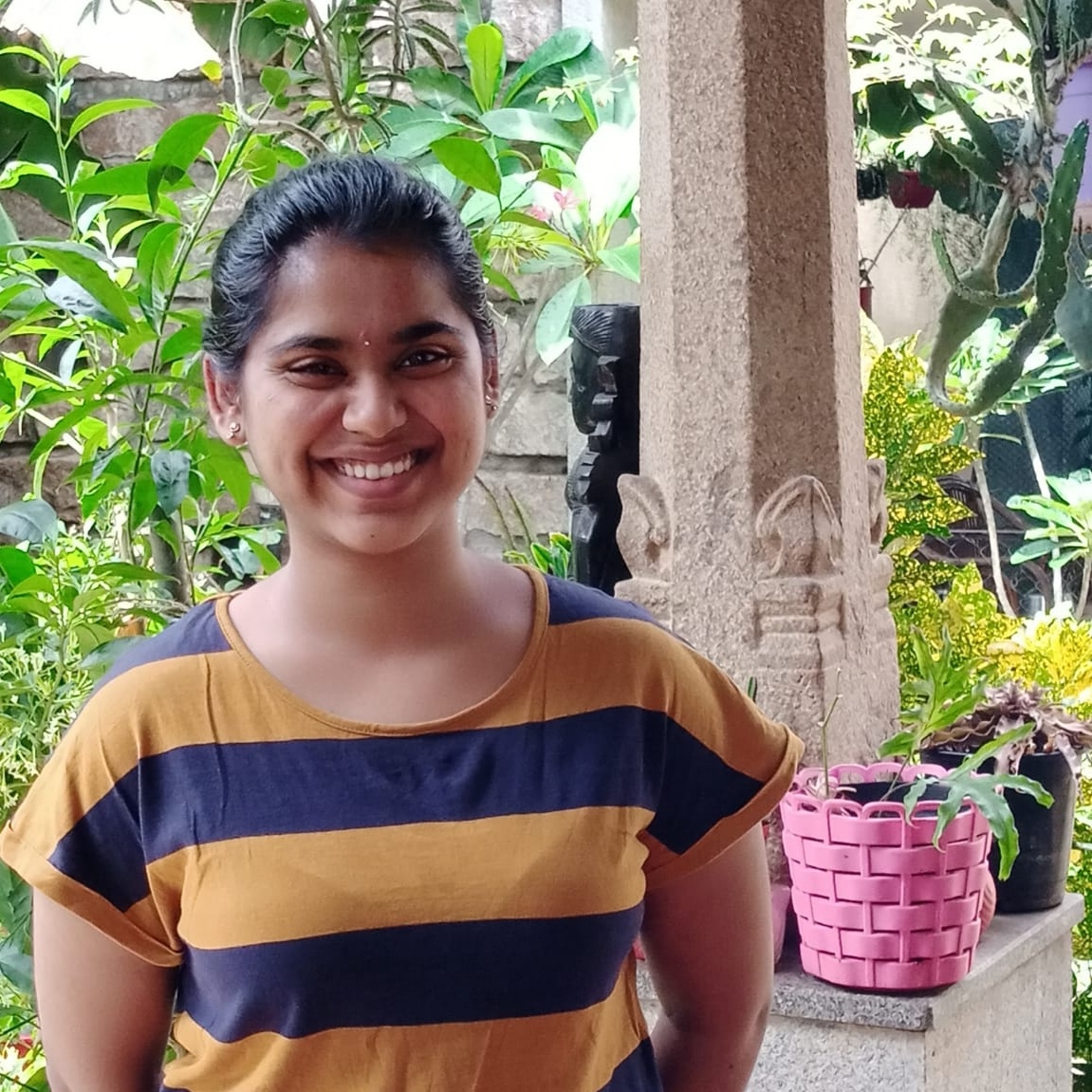 Ms Sreelekha Bhuvaneswari, a BSc physics final year student, in SRM University AP, Andhra Pradesh, filed a patent for her work titled “A fibre material with moisture retention capacity with thermal tolerance and a method for manufacture” under the guidance of Dr Sabyasachi Mukhopadhyay, Assistant Professor, Department of Physics, SRM University-AP.
Ms Sreelekha Bhuvaneswari, a BSc physics final year student, in SRM University AP, Andhra Pradesh, filed a patent for her work titled “A fibre material with moisture retention capacity with thermal tolerance and a method for manufacture” under the guidance of Dr Sabyasachi Mukhopadhyay, Assistant Professor, Department of Physics, SRM University-AP.The project, with the patent application number 202141023375, develops a methodology to design a fabric cloth that would replace the use of air conditioners. This cloth design is inspired by Saharan silver ants which regulate their body temperatures in the scorching desert heat and also from the cooling properties of clay. This research would significantly scale down the usage of AC and other cooling devices in warm places, thus reducing the use of electricity and emission of greenhouse gases to the environment. As this cloth would be environment friendly with long durability and cost-efficiency, Sreelekha hopes that this research would bridge the socioeconomic divide of haves and have-nots between communities.
“I am grateful to Dr Sabyasachi sir for his constant help and guidance along the way. There were several failed models, but he believed in the concept and that inspired me to go forward with the project,” said Ms Bhuvaneswari. “The facilities at the University made the process seamless; once the proposal was made, the procedure was automated. I thank the officials of SRM University-AP for believing in my proposal and helping me get through the procedures smoothly. If it were not for the facilities available at my university, I could not have finished the design,” She added.
Continue reading → - Department of Physics set to work on bilateral project with IIT Bhilai June 10, 2021
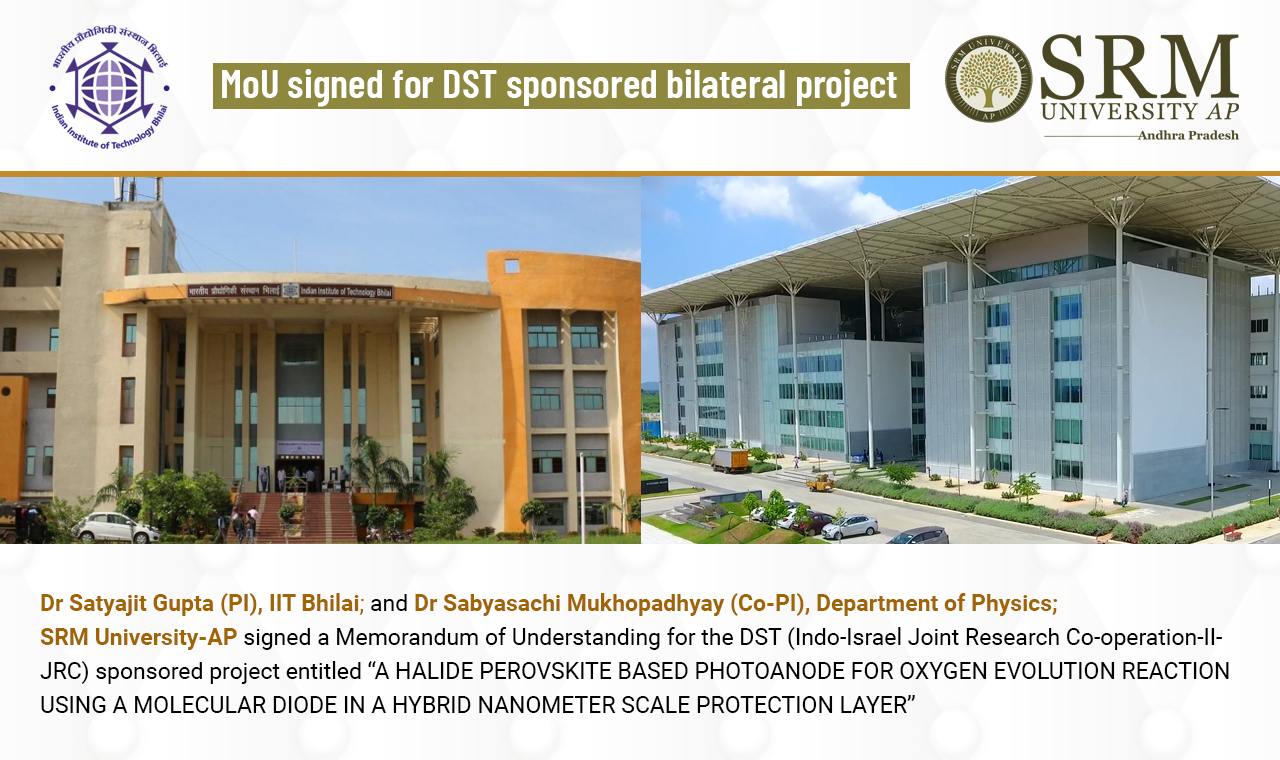 Dr. Satyajit Gupta (PI), IIT Bhilai, and Dr Sabyasachi Mukhopadhyay (Co-PI), Department of Physics, SRM University-AP has signed a Memorandum of Understanding for the DST (Indo-Israel Joint Research Co-operation-IIJRC) sponsored project entitled “A HALIDE PEROVSKITE BASED PHOTOANODE FOR OXYGEN EVOLUTION REACTION USING A MOLECULAR DIODE IN A HYBRID NANOMETER SCALE PROTECTION LAYER”, Sanction Order NO. – DST/INT/ISR/P-28/2020(G). The project is a bilateral project and Foreign PI is Dr Eran Edri, Department of Chemical Engineering, Ben-Gurion University of the Negev, Israel. This MoU will help Dr Mukhopadhyay to utilize the fund under this project as co-PI, and the facility of IIT Bhilai to complete the objective of the project.
Dr. Satyajit Gupta (PI), IIT Bhilai, and Dr Sabyasachi Mukhopadhyay (Co-PI), Department of Physics, SRM University-AP has signed a Memorandum of Understanding for the DST (Indo-Israel Joint Research Co-operation-IIJRC) sponsored project entitled “A HALIDE PEROVSKITE BASED PHOTOANODE FOR OXYGEN EVOLUTION REACTION USING A MOLECULAR DIODE IN A HYBRID NANOMETER SCALE PROTECTION LAYER”, Sanction Order NO. – DST/INT/ISR/P-28/2020(G). The project is a bilateral project and Foreign PI is Dr Eran Edri, Department of Chemical Engineering, Ben-Gurion University of the Negev, Israel. This MoU will help Dr Mukhopadhyay to utilize the fund under this project as co-PI, and the facility of IIT Bhilai to complete the objective of the project.The Objectives of the MoU are to promote effective application of resources through Indo-Israel Joint Research Co-operation-(IIJRC) sponsored project, promote mentorship and research guidance, and cooperate in educational/research areas of mutual interest. It also aims to promote international collaborations through International travel of Party, hosting International delegates, and through a student exchange programme between Indian Institute/Universities and Ben-Gurion University of the Negev, Israel.
The MoU will provide a platform to share and exchange Best Practices, and facilitate exchange programmes for students. Dr Satyajt Gupta and Dr Sabyasachi Mukhopadhyay will provide training and development for students working under this joint project.
Continue reading → - Renowned physicists deliver talks at the “One-Day National Symposium on High Energy Physics.” June 4, 2021
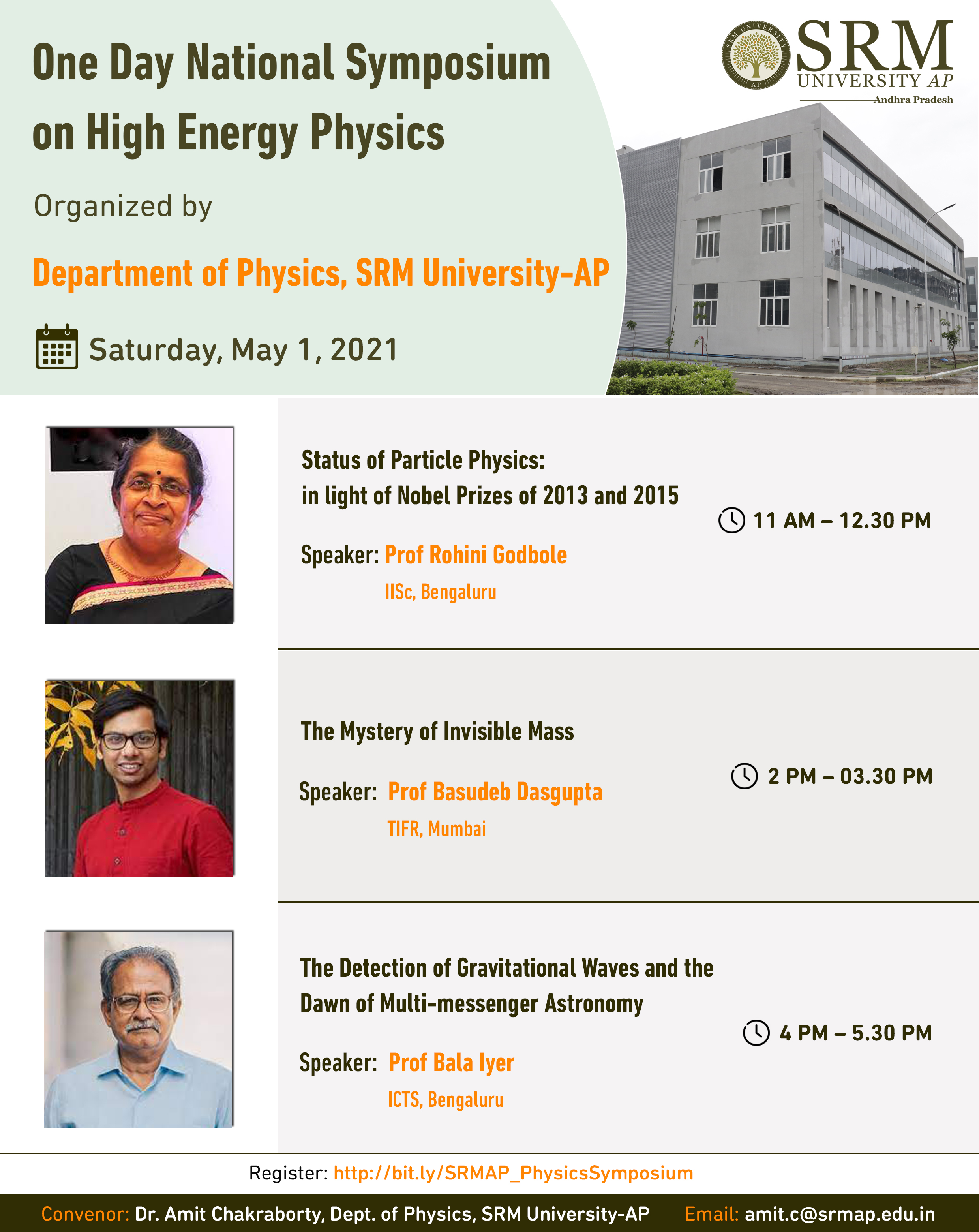 The Department of Physics, SRM University-AP organized a “One-day National Symposium on High Energy Physics” on Saturday, May 1, 2021. The session was held through online mode in the presence of honourable leaders of the university, faculty members, and attendees from various fields of interest. Prof V S Rao, the Vice-Chancellor, SRM University-AP, welcomed the gathering with a brief overview of the university’s inception and quick progress in the field of research.
The Department of Physics, SRM University-AP organized a “One-day National Symposium on High Energy Physics” on Saturday, May 1, 2021. The session was held through online mode in the presence of honourable leaders of the university, faculty members, and attendees from various fields of interest. Prof V S Rao, the Vice-Chancellor, SRM University-AP, welcomed the gathering with a brief overview of the university’s inception and quick progress in the field of research. Three talks at the pedagogical level were organised for a wider audience, especially for the students of basic sciences and engineering streams. The first speaker, a Padma Shri awardee, Prof Rohini Godbole, who is a theoretical particle physicist at Indian Institute of Science (IISc), Bengaluru expounded on “Status of Particle Physics: in light of Nobel Prizes of 2013 and 2015”. She talked about the Higgs Boson’s theoretical postulate, for which the Nobel Prize in Physics was granted in 2013. According to studies, it was the final missing element in the Standard Model’s periodic table (SM). Her paper incorporated the experimental finding of the Neutrino Oscillation, as well as many compelling pieces of evidence that led to the 2015 Nobel Prize.
In the afternoon session, the talks were on the burgeoning field of Dark Matter physics and Gravitational-wave astronomy. Prof Basudeb Dasgupta from Tata Institute of Fundamental Research (TIFR), Mumbai apprised the participants on “The Mystery of Invisible Mass”. The deep understanding and expertise of Prof Dasgupta in the interfaces of particle physics, astrophysics, and cosmology with a particular emphasis on dark matter and neutrino physics as a theoretical physicist at the Tata Institue of Fundamental Research (TIFR) enlightened the audience. He stated that the human beings are able to see only 20% of the universe’s celestial objects; the remaining 80% are unseen and are referred to as “dark matter.” In his words, “Billions of years after the Big Bang, all we can see is the cloud’s surface, where the light is scattered.” Prof Basudeb, is a frequent speaker at prestigious international and national conferences and is a youth icon for aspiring physicists and scientists.
The final lecture of the day was delivered by Prof Bala Iyer from International Centre for Theoretical Sciences (ICTS), Bengaluru on “The Detection of Gravitational Waves and the Dawn of Multi-messenger Astronomy” at 4.00 pm. Prof Iyer is currently the Simons Visiting Professor at ICTS-TIFR Bangalore and co-PI of the LIGO-India Scientific Collaboration. He coaches and guides young minds interested in astrophysics, cosmology, and fundamental physics. Prof Iyer did a presentation on the discovery of gravitational waves from a binary black hole in 2015, which was a watershed moment and necessitated the launch of a new multi-messenger astronomy with the potential to have a significant impact on astrophysics. “Any relativistic theory of gravity must be consistent with the special relativity principle. Gravity’s effect cannot travel faster than the speed of light. If an item’s gravitational field changes, the changes propagate over space and take a certain amount of time to reach the object “, he added.
The symposium that aimed to discuss the current status of exciting research topics of High Energy Physics concluded with a Q&A session. This has proved that the faculty members and participants were highly inspired and motivated after attending the symposium and listening to the scholars.
Pre-Event Release: https://srmap.edu.in/events/national-symposium-on-high-energy-physics-2021/
Continue reading → - Novel designs for electrochemical ammonia synthesis to substitute Haber-Bosch process May 26, 2021
 Professor Ranjit Thapa, Head of the Department of Physics, has recently published a paper “Unveiling the Genesis of the High Catalytic Activity in Nickel Phthalocyanine for Electrochemical Ammonia Synthesis” in the renowned Journal of Materials Chemistry A, Royal Society of Chemistry (Impact Factor: 11.301). The work has been done in collaboration with the Department of Industrial Chemistry & Applied Chemistry, Swami Vivekananda Research Centre, Ramakrishna Mission Vidyamandira, Belur Math, Howrah; Rubber Technology Centre, Indian Institute of Technology, Kharagpur; and Atomic & Molecular Physics Division, Bhabha Atomic Research Centre, Mumbai, India.
Professor Ranjit Thapa, Head of the Department of Physics, has recently published a paper “Unveiling the Genesis of the High Catalytic Activity in Nickel Phthalocyanine for Electrochemical Ammonia Synthesis” in the renowned Journal of Materials Chemistry A, Royal Society of Chemistry (Impact Factor: 11.301). The work has been done in collaboration with the Department of Industrial Chemistry & Applied Chemistry, Swami Vivekananda Research Centre, Ramakrishna Mission Vidyamandira, Belur Math, Howrah; Rubber Technology Centre, Indian Institute of Technology, Kharagpur; and Atomic & Molecular Physics Division, Bhabha Atomic Research Centre, Mumbai, India.The slow kinetics of N2 adsorption, splitting of the strong N≡N bond are the challenges for the electrocatalytic nitrogen reduction reaction (NRR) process. In the electrocatalytic NRR process, the fast reaction kinetics of hydrogen evolution reaction is the greatest obstacle. To solve these challenges, the search for various types of catalysts is on a roll. Also, identifying active sites responsible for the origin of catalytic activity in transition metal phthalocyanine is difficult due to its complex structure. Herein, density functional theory (DFT) has been applied to identify the probable active sites of nickel phthalocyanine (NiPc) in NRR as well as the origin of catalytic activity, which is associated with d band centre and density of states (DOS) of Ni in NiPc. Accordingly, the NiPc nanorods (NRs) were synthesised by the solvothermal method on a large scale and the chemically prepared NiPc NRs exhibit the NH3 yield rate of about 85 μg h-1mgcat-1.
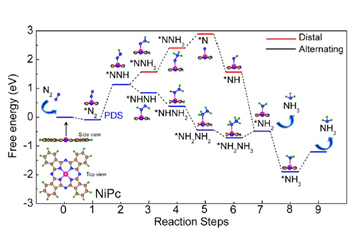 In 2019, the global production capacity of ammonia was 235 million metric tons which will increase to 290 million metric tons by 2030. This emphasis on ammonia is due to its application in broad and diverse fields, such as fertilisers, textiles, pharmaceutical, and carbon-free energy carriers. The Haber-Bosch process is used to synthesise ammonia (NH3) from N2 and H2 using Fe based catalyst. However, the process emits carbon dioxide (CO2) (1.5 tons of CO2/tons of NH3 production) and requires high pressure and temperature and consumes around 2% of the global energy supply. Electrocatalytic N2 fixation (N2 + 6H+ + 6e− → 2NH3) showed great potential due to the possible use of atmospheric nitrogen and hydrogen derived from water through electrolysis and in mild conditions.
In 2019, the global production capacity of ammonia was 235 million metric tons which will increase to 290 million metric tons by 2030. This emphasis on ammonia is due to its application in broad and diverse fields, such as fertilisers, textiles, pharmaceutical, and carbon-free energy carriers. The Haber-Bosch process is used to synthesise ammonia (NH3) from N2 and H2 using Fe based catalyst. However, the process emits carbon dioxide (CO2) (1.5 tons of CO2/tons of NH3 production) and requires high pressure and temperature and consumes around 2% of the global energy supply. Electrocatalytic N2 fixation (N2 + 6H+ + 6e− → 2NH3) showed great potential due to the possible use of atmospheric nitrogen and hydrogen derived from water through electrolysis and in mild conditions.In their future endeavours, Prof Thapa and his research group will design different types of such single-atom catalyst (SAC) considering different metal atoms and their surrounding non-metals. Dr Thapa’s team necessitates addressing the above problem to fill the gap, which could be the energy equation, energy parameter and electronic descriptor, to help them predict the best SAC catalyst in the large catalyst space for eNRR over HER. The solution is much needed through density functional theory to understand the origin and design principle and lower the time for trials by experimentalists in the laboratory. Prof Thapa is working on energy equations that can predict the best catalyst for eNRR over HER. They defined four regions to find the SAC catalyst for eNRR over HER (1) catalyst for NRR with almost nil HER probability (ii) catalyst for NRR with low HER probability (iii) HER over NRR and (iv) NRR is possible but with H poisoning. Overall, the energy parameter and descriptor to find NRR over HER is a fundamental problem, and the database is a platform to be used by experimentalists and is the key idea.
Read the full paper: https://doi.org/10.1039/D1TA00766A.
Continue reading →

